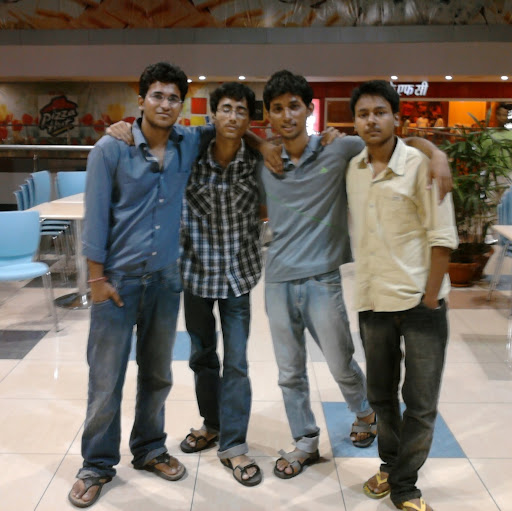Prabhat M Gupta
age ~60
from Edison, NJ
- Also known as:
-
- Gupta Prabhat
- T Gupta
- Phone and address:
-
211 Monroe Ave, Edison, NJ 08820
(732)7440640
Prabhat Gupta Phones & Addresses
- 211 Monroe Ave, Edison, NJ 08820 • (732)7440640 • (732)7441032 • (732)6591690
- 106 Nelson Ave, Jersey City, NJ 07307 • (201)6591690
- Columbia, MD
- 211 Monroe Ave, Edison, NJ 08820 • (732)3977782
Work
-
Position:Construction and Extraction Occupations
Education
-
Degree:Bachelor's degree or higher
Us Patents
-
Voiced, Unvoiced Or Noise Modes In A Celp Vocoder
view source -
US Patent:57347891, Mar 31, 1998
-
Filed:Apr 18, 1994
-
Appl. No.:8/229271
-
Inventors:Kumar Swaminathan - Gaithersburg MD
Kalyan Ganesan - Germantown MD
Prabhat K. Gupta - Germantown MD -
Assignee:Hughes Electronics - Los Angeles CA
-
International Classification:G10L 900
-
US Classification:395 215
-
Abstract:A bit rate Codebook Excited Linear Predictor (CELP) communication system which includes a transmitter that organizes a signal containing speech into frames of 40 millisecond duration, and classifies each frame as one of three modes: voiced and stationary, unvoiced or transient, and background noise.
-
Mode-Specific Method And Apparatus For Encoding Signals Containing Speech
view source -
US Patent:55966764, Jan 21, 1997
-
Filed:Oct 11, 1995
-
Appl. No.:8/540637
-
Inventors:Kumar Swaminathan - Gaithersburg MD
Kalyan Ganesan - Germantown MD
Prabhat K. Gupta - Germantown MD -
Assignee:Hughes Electronics - Los Angeles CA
-
International Classification:G10L 912
G10L 914 -
US Classification:395 217
-
Abstract:A method for encoding a signal that includes a speech component is described. First and second linear prediction windows of a frame are analyzed to generate sets of filter coefficients. First and second pitch analysis windows of the frame are analyzed to generate pitch estimates. The frame is classified in one of at least two modes, e. g. voiced, unvoiced and noise modes, based, for example, on pitch stationarity, short-term level gradient or zero crossing rate. Then the frame is encoded using the filter coefficients and pitch estimates in a particular manner depending upon the mode determination for the frame, preferably employing CELP based encoding algorithms.
-
Real-Time Implementation Of A 8Kbps Celp Coder On A Dsp Pair
view source -
US Patent:54917719, Feb 13, 1996
-
Filed:Mar 26, 1993
-
Appl. No.:8/037193
-
Inventors:Prabhat K. Gupta - Germantown MD
Allan Lamkin - Arlington VA
Walter R. Kepley - Gaithersburg MD -
Assignee:Hughes Aircraft Company - Los Angeles CA
-
International Classification:G10L 302
G10L 900 -
US Classification:395 232
-
Abstract:A codec uses low cost digital signal processors (DSPs) to implement the codebook excited linear prediction (CELP) algorithm. The flexible architecture provides a platform for implementing a family of CELP codecs. In a specific example, an 8 Kbps CELP codec is partitioned into parallel tasks for real time implementation on dual DSPs with flexible intertask communication, prioritization and synchronization with asynchronous transmit and receive frame timings. The two DSPs are used in a master-slave pair. Each DSP has its own local memory. The DSPs communicate to each other through interrupts. Messages are passed through a dual port RAM. Each dual port RAM has separate sections for command-response and for data.
-
Echo Suppressor For Facsimile Calls In A Satellite Network
view source -
US Patent:57937559, Aug 11, 1998
-
Filed:Jul 7, 1995
-
Appl. No.:8/499421
-
Inventors:Prabhat K. Gupta - Germantown MD
Sanjay Gupta - Germantown MD
Paul Gaske - Rockville MD
Bob Kepley - Gaithersburg MD -
Assignee:Hughes Electronics Corporation - El Segundo CA
-
International Classification:H04B 320
-
US Classification:370286
-
Abstract:A signal classifier and a echo suppressor for a facsimile calls in an echo prone network. The signal classifier quickly and reliably differentiates facsimile calls from voice and modem calls. The echo suppressor suppresses echo and has a variable hangover time which avoids attenuating and distorting a return transmission signal.
-
Method For Synthesizing An Echo Path In An Echo Canceller
view source -
US Patent:56490127, Jul 15, 1997
-
Filed:Sep 15, 1995
-
Appl. No.:8/529042
-
Inventors:Prabhat K. Gupta - Germantown MD
Sanjay Gupta - Germantown MD -
Assignee:Hughes Electronics - Los Angeles CA
-
International Classification:H04B 323
-
US Classification:379410
-
Abstract:A method of synthesizing an echo path in an echo canceller is provided. The method includes the steps of obtaining near end and far end signal samples at an echo canceller, locating the echo in a background task using a whitened version of the signal, transferring the echo location information to a foreground task, and eliminating the echo in the incoming signals by filtering the signal in the location passed to the foreground task by the background task.
-
Voice Activity Detector For Speech Signals In Variable Background Noise
view source -
US Patent:54598141, Oct 17, 1995
-
Filed:Mar 26, 1993
-
Appl. No.:8/038734
-
Inventors:Prabhat K. Gupta - Germantown MD
Shrirang Jangi - Germantown MD
Allan B. Lamkin - Arlington VA
W. Robert Kepley - Gaithersburg, MD
Adrian J. Morris - Gaithersburg, MD -
Assignee:Hughes Aircraft Company - Los Angeles CA
-
International Classification:G10L 900
-
US Classification:395 242
-
Abstract:A voice activity detector (VAD) which determines whether an input signal contains speech by deriving parameters measuring short term time domain characteristics of the input signal, including the average signal level and the absolute value of any change in average signal level, and comparing the derived parameter values with corresponding predetermined threshold values. In order to further minimize clipping and false alarms, the VAD periodically monitors and updates the threshold values to reflect changes in the level of background noise.
-
Method Of Detecting Double Talk In An Echo Canceller
view source -
US Patent:58094636, Sep 15, 1998
-
Filed:Sep 15, 1995
-
Appl. No.:8/528967
-
Inventors:Sanjay Gupta - Germantown MD
Prabhat K. Gupta - Germantown MD -
Assignee:Hughes Electronics - Los Angeles CA
-
International Classification:G10L 900
-
US Classification:704233
-
Abstract:A method of detecting double talk in an echo canceller is provided. The method includes determining far end, near end and echo signal cancelled power, determining the presence of near end, maybe near end and far end speech, and controlling an echo suppressor and filter coefficient updates in an echo canceller.
-
Method Of Detecting Narrow-Band Signals In An Echo Canceller
view source -
US Patent:56895569, Nov 18, 1997
-
Filed:Sep 15, 1995
-
Appl. No.:8/528762
-
Inventors:Prabhat K. Gupta - Germantown MD
Sanjay Gupta - Germantown MD -
Assignee:Hughes Electronics - Los Angles CA
-
International Classification:H04B 323
-
US Classification:379410
-
Abstract:A method of detecting narrow-band signals in an echo canceller to control the coefficient update process, echo suppression process, and the disablement of the echo canceller is provided. The method includes the steps of searching for the presence of a generic tone, searching for DTMF tones, searching for a 2100 Hz tone and, if a generic tone is found, searching for a dial tone. If a generic tone is detected on the far end signal, a tone flag is set which triggers the disablement of the echo canceller coefficient update process and the enablement of the echo suppressor process. If a 2100 Hz tone is detected, the echo canceller is disabled. If a DTMF signal is detected, DTMF flags are set which are used by the echo suppressor for suppressing the near end echo. Finally, if a dial tone is detected, dial tone flags are set which cause the disablement of the echo suppressor.
Resumes

Sr. Network Analyst At State University Of Ny - Downstate Medical Ctr
view sourcePosition:
Sr. Network Analyst at State University of NY - Downstate Medical Ctr
Location:
Greater New York City Area
Industry:
Computer & Network Security
Work:
State University of NY - Downstate Medical Ctr
Sr. Network Analyst
Kodak (India) Ltd Aug 1987 - Jun 1990
Sales & Service Engineer
Sr. Network Analyst
Kodak (India) Ltd Aug 1987 - Jun 1990
Sales & Service Engineer
Education:
St. Peter's College 1996 - 2001
MBA, MIS Dayalbagh Educational Institute 1981 - 1985
BS, Electrical Engineering
MBA, MIS Dayalbagh Educational Institute 1981 - 1985
BS, Electrical Engineering

Prabhat Gupta
view sourceLocation:
United States

Prabhat Gupta
view sourceLocation:
United States

Prabhat Gupta
view source
Prabhat Gupta
view sourceName / Title
Company / Classification
Phones & Addresses
Principal
P T I G, LLC
Business Services at Non-Commercial Site · Nonclassifiable Establishments
Business Services at Non-Commercial Site · Nonclassifiable Establishments
37 Baxter Ln, Town Center, NJ 07052
Principal
Pharma R&D Services LLC
Services-Misc
Services-Misc
3 Melvin Ave, Iselin, NJ 08830
Googleplus

Prabhat Gupta
Work:
Hindustan Unilever Limited - HR (2007)
Education:
MBA - HR

Prabhat Gupta
Education:
Bosco public school, Manav sthali school

Prabhat Gupta
Education:
CHRIST THE KING COLLEGE, KIET COLLEGE

Prabhat Gupta
Education:
Indian Institute of Technology Kanpur

Prabhat Gupta
Education:
S.g.r.r public school

Prabhat Gupta
Education:
C.s.j.m.

Prabhat Gupta
Tagline:
Lets do it

Prabhat Gupta
Flickr
Myspace

Prabhat Kumar Gupta
view source
Prabhat Kumar Gupta
view source
Prabhat Kumar Gupta
view source
Prabhat Chandra Gupta
view source
Prabhat Kumar Gupta
view source
Prabhat Gupta
view source
Prabhat Gupta Kumar
view source
Prabhat Ranjan Gupta
view sourceYoutube
Get Report for Prabhat M Gupta from Edison, NJ, age ~60
















